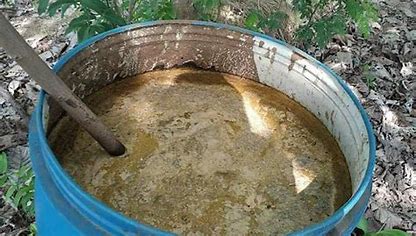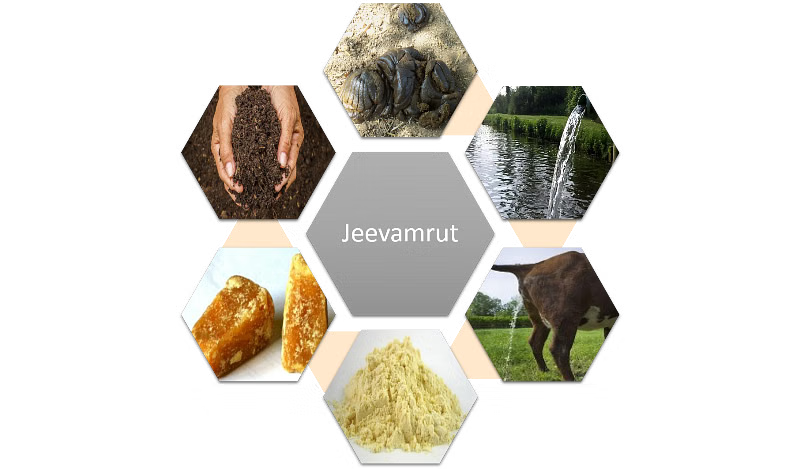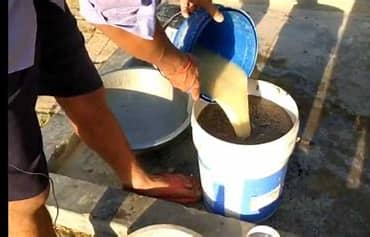Wheat is a staple crop that requires specific soil management and fertilization practices to achieve ...
पौधों के स्वस्थ विकास और अधिक पैदावार के लिए उच्च गुणवत्ता वाली जैविक खाद और अन्य प्राकृतिक तत्व आवश्यक हैं। जीवामृत मिट्टी की उर्वरता बढ़ाने और फसल उत्पादन सुधारने में वरदान साबित होता है। यह मिट्टी में कार्बनिक अवशेषों को तेजी से सड़ने में मदद करता है और पोषक तत्व बढ़ाता है। आजकल खेती में रासायनिक खादों का अधिक प्रयोग मिट्टी की गुणवत्ता को कम कर रहा है। ऐसी स्थिति में जैविक खाद का महत्व किसानों और बागवानों के लिए तेजी से बढ़ रहा है। तो आइए जानते हैं, जीवामृत क्या है और इसे कैसे बनाया जाता है।
For the healthy growth of plants and higher yield, high-quality organic manure and other natural elements are essential. Jeevamrut is nothing short of a boon for enhancing soil fertility and improving crop production. It helps in the rapid decomposition of organic residues in the soil and increases its nutrient content. Nowadays, excessive use of chemical fertilizers and pesticides in farming is reducing soil quality. In such a situation, the importance of organic manure is rapidly increasing for farmers and gardeners. So, let’s understand what Jeevamrut is and how it is prepared.
जीवामृत एक पारंपरिक भारतीय जैविक खाद और जैविक कीटनाशक है, जिसे गाय का गोबर, गोमूत्र, गुड़, दाल का आटा, मिट्टी और पानी मिलाकर किण्वन की प्रक्रिया से तैयार किया जाता है। यह मिश्रण फसलों के लिए कार्बन, बायोमास, नाइट्रोजन, फॉस्फोरस, पोटैशियम और कई सूक्ष्म पोषक तत्वों का बेहतरीन स्रोत होता है।
जीवामृत की खासियत यह है कि यह पूरी तरह सस्ता, प्राकृतिक और पौधों व मिट्टी दोनों के लिए लाभकारी है। जिन किसान भाइयों को रासायनिक खाद और कीटनाशकों पर ज्यादा खर्च करना पड़ता है, वे जीवामृत का उपयोग करके अपनी लागत कम कर सकते हैं और अच्छी पैदावार ले सकते हैं।
गार्डनिंग के लिए भी जीवामृत एक 100% जैविक उर्वरक है, जिसका मिट्टी की सेहत पर कोई नकारात्मक प्रभाव नहीं पड़ता। यह संस्कृत के दो शब्दों “जीवन” और “अमृत” से मिलकर बना है, जिसका अर्थ है – जीवन के लिए अमृत।

जीवामृत आमतौर पर तीन प्रकार का होता है।
तरल जीवामृत को तैयार करने के लिए गाय का गोबर, गोमूत्र, पानी, थोड़ी सी मिट्टी, गुड़ और दाल का आटा (या बेसन) आपस में मिलाए जाते हैं।
अगर आपके पास गोबर की पर्याप्त मात्रा उपलब्ध है, तो उससे आप आसानी से अर्द्ध ठोस जीवामृत तैयार कर सकते हैं। इसके लिए 50 किलो गोबर में 2 लीटर गोमूत्र, लगभग आधा किलो गुड़, आधा किलो दाल का आटा और एक मुट्ठी उपजाऊ मिट्टी मिलाएँ। इस मिश्रण में थोड़ा पानी डालकर अच्छे से गूँथ लें और छोटे-छोटे गोले (लड्डू) बना लें। इन गोलों को धूप में सुखा लें। जब ये सूखे गोले खेत में स्प्रिंकलर के नीचे रखे जाते हैं, तो उन पर गिरने वाला पानी लाभकारी सूक्ष्मजीवों को सक्रिय कर देता है, जिससे फसल और मिट्टी दोनों को फायदा होता है।
सूखा जीवामृत, जिसे घन जीवामृत भी कहा जाता है, बनाने में पानी की आवश्यकता नहीं होती। इसकी खासियत यह है कि आप इसे एक बार तैयार करके लंबे समय तक सुरक्षित रख सकते हैं और जरूरत पड़ने पर आसानी से उपयोग कर सकते हैं।

पौधों की बेहतर वृद्धि के लिए तरल और ठोस दोनों प्रकार का जीवामृत लाभदायक होता है।
तरल जीवामृत : 5–10% जीवामृत को पानी में मिलाकर पौधों पर स्प्रे करें। अच्छे परिणाम के लिए यह स्प्रे हर 7–14 दिन के अंतराल पर दोहराएँ। चाहें तो इसे सीधे सब्जी वाले गमलों या खेत की मिट्टी में भी डाल सकते हैं।
ठोस जीवामृत (घन जीवामृत) : इसे सीधे बगीचे या खेत में वर्मी कम्पोस्ट या फार्म यार्ड मैन्योर की तरह पाउडर रूप में मिट्टी में डाल सकते हैं।
गार्डन में जीवामृत का पहला स्प्रे बीज बोने के लगभग 1 महीने बाद करना चाहिए। इसके लिए 50 लीटर पानी में 2½ लीटर तरल जीवामृत अच्छी तरह मिलाएँ और घोल को अच्छे से हिलाएँ। इस घोल का छिड़काव सब्जी के पौधों की पत्तियों और तनों पर करें। गर्मी के मौसम में स्प्रे हमेशा सुबह या शाम को करें, जबकि सर्दियों में दिन के किसी भी समय छिड़काव किया जा सकता है। जब पौधों में फूल, फल या सब्जियाँ आने लगें, तो स्प्रे के लिए 50 लीटर पानी में 2 लीटर खट्टी छाछ मिलाकर उपयोग करें।

अगर आपके पास पानी कम मात्रा में है या स्प्रेयर पंप उपलब्ध नहीं है, तो भी आप जीवामृत का उपयोग कर सकते हैं। बीज बोने के बाद पहले महीने में, दो सब्जी के पौधों के बीच की मिट्टी पर लगभग 1 कप जीवामृत डालें। इस प्रक्रिया को महीने में 2 से 3 बार दोहराया जा सकता है।
पोषक तत्वों का बेहतरीन स्रोत – जीवामृत में नाइट्रोजन, फॉस्फोरस, पोटैशियम और अन्य सूक्ष्म पोषक तत्व प्रचुर मात्रा में होते हैं, जो पौधों की वृद्धि और विकास में मदद करते हैं।
100% जैविक उर्वरक – यह पूरी तरह से ऑर्गेनिक है और पौधों को सभी आवश्यक पोषण देता है। साथ ही यह कीटों और बीमारियों से भी सुरक्षा प्रदान करता है।
तेजी से तैयार होने वाला खाद – जहाँ अन्य जैविक खाद को बनने में महीनों लग जाते हैं, वहीं जीवामृत केवल 1 सप्ताह के भीतर तैयार किया जा सकता है।
मिट्टी की गुणवत्ता सुधारता है – यह मिट्टी के pH को संतुलित करता है, मिट्टी की वायु संचार क्षमता को बढ़ाता है और लाभकारी सूक्ष्मजीवों को सक्रिय करता है।
हर प्रकार के पौधों के लिए उपयुक्त – चाहे सब्जियाँ हों, फलदार पौधे या गार्डनिंग के पौधे, जीवामृत सभी के लिए उपयोगी है।
सस्ता और आसानी से उपलब्ध – इसे बनाने की सारी सामग्री ग्रामीण इलाकों और खेतों में आसानी से मिल जाती है, जिससे किसान इसे कम लागत में बना कर अधिक मुनाफा कमा सकते हैं।
पोषक तत्वों का बेहतर अवशोषण – जीवामृत डालने से पौधे मिट्टी से पोषक तत्वों को जल्दी और आसानी से ग्रहण कर पाते हैं।
केंचुओं की संख्या बढ़ाता है – यह मिट्टी में केंचुओं की वृद्धि करता है। केंचुए मिट्टी को भुरभुरा बनाते हैं और जड़ों तक ऑक्सीजन पहुँचाने में मदद करते हैं।
मिट्टी की उपजाऊ शक्ति बढ़ाता है – इसके उपयोग से मिट्टी की उर्वरता बढ़ती है और वह लंबे समय तक उपजाऊ बनी रहती है।
लाभकारी सूक्ष्मजीवों का विकास – जीवामृत अच्छे बैक्टीरिया, जीवाणु और सूक्ष्मजीवों की संख्या को बढ़ाता है, जिससे मिट्टी का स्वास्थ्य सुधरता है।
पोषक तत्वों का विघटन – यह मिट्टी में मौजूद पोषक तत्वों को तोड़कर पौधों की जड़ों तक पहुँचने में मदद करता है।
जीवामृत एक बेहद उपयोगी और किफायती जैविक खाद है, जो रासायनिक खाद और महंगे कीटनाशकों का बेहतर विकल्प साबित हो सकता है। इसका सबसे बड़ा लाभ यह है कि यह पौधों और मिट्टी पर कोई भी दुष्प्रभाव नहीं डालता। इसे बहुत कम लागत में घर या खेत पर आसानी से तैयार किया जा सकता है। यही कारण है कि आज खेती और गार्डनिंग दोनों में जीवामृत का महत्व लगातार बढ़ता जा रहा है।
Jeevamrut is a traditional Indian organic manure and bio-pesticide, prepared by fermenting cow dung, cow urine, jaggery, lentil flour, soil, and water. This mixture is an excellent source of carbon, biomass, nitrogen, phosphorus, potassium, and several micronutrients essential for crops.
The special feature of Jeevamrut is that it is completely affordable, natural, and beneficial for both plants and soil. Farmers who spend heavily on chemical fertilizers and pesticides can reduce their costs by using Jeevamrut while achieving better crop yields.
Jeevamrut is also a 100% organic fertilizer suitable for gardening, without any negative impact on soil health. The word Jeevamrut comes from two Sanskrit words, "Jeevan" and "Amrit," meaning "nectar for life."
Jeevamrut is generally available in three types:
To prepare liquid Jeevamrut, cow dung, cow urine, water, a little soil, jaggery, and lentil flour (or gram flour) are mixed together.
If you have a sufficient amount of cow dung, you can easily prepare semi-solid Jeevamrut. For this, mix 50 kg of cow dung with 2 liters of cow urine, about ½ kg of jaggery, ½ kg of lentil flour, and a handful of fertile soil. Add a little water, knead well, and form small balls. Dry these balls in the sun. When these dried balls are placed under a sprinkler in the field, water falling on them activates beneficial microbes, which benefits both the crop and the soil.
Dry Jeevamrut, also called solid Jeevamrut, does not require water for preparation. Its advantage is that it can be prepared once and stored safely for a long time, to be used whenever needed.
Both liquid and solid forms of Jeevamrut are beneficial for better plant growth.
Liquid Jeevamrut: Mix 5–10% Jeevamrut with water and spray it on plants. For best results, repeat this spray every 7–14 days. Alternatively, it can be applied directly to vegetable pots or farm soil.
Solid Jeevamrut (Ghan Jeevamrut): Can be applied directly to soil like vermicompost or farmyard manure in powdered form.
The first spray of Jeevamrut should be done about 1 month after sowing seeds. Mix 2½ liters of liquid Jeevamrut in 50 liters of water and stir well. Spray this mixture on the leaves and stems of vegetable plants. During summer, spraying should be done in the morning or evening, while in winter, it can be done any time of the day. When flowers, fruits, or vegetables start to appear, use 2 liters of sour buttermilk in 50 liters of water for spraying.
If you have limited water or no sprayer, you can still use Jeevamrut manually. After sowing seeds, apply about 1 cup of Jeevamrut to the soil between two vegetable plants during the first month. Repeat this process 2–3 times a month.
Excellent Source of Nutrients – Jeevamrut is rich in nitrogen, phosphorus, potassium, and other micronutrients that help in plant growth and development.
100% Organic Fertilizer – It is completely organic and provides all essential nutrition to plants while also protecting them from pests and diseases.
Quick Preparation – While other organic manures take months to prepare, Jeevamrut can be ready within just 1 week.
Improves Soil Quality – It balances soil pH, enhances aeration, and activates beneficial microbes.
Suitable for All Plants – Whether vegetables, fruit-bearing plants, or other plants, Jeevamrut is useful for all.
Affordable and Easily Available – All ingredients are easily available in rural areas and farms, allowing farmers to prepare it at low cost and increase profit.
Better Nutrient Absorption – Jeevamrut helps plants absorb nutrients from the soil quickly and easily.
Increases Earthworm Population – It promotes earthworm growth, which loosens the soil and improves oxygen supply to roots.
Enhances Soil Fertility – It increases soil fertility and keeps it productive for a long time.
Promotes Beneficial Microbes – Jeevamrut boosts beneficial bacteria and microbes, improving overall soil health.
Breaks Down Nutrients – It decomposes nutrients in the soil and makes them easily available to plant roots.
Jeevamrut is a highly useful and cost-effective organic fertilizer, serving as a better alternative to chemical fertilizers and expensive pesticides. Its biggest advantage is that it has no harmful effects on plants or soil. It can be easily prepared at home or on the farm at minimal cost. This is why the importance of Jeevamrut in farming and gardening is continuously increasing.
0
0
Wheat is a staple crop that requires specific soil management and fertilization practices to achieve ...
भारत में कृषि न केवल एक प्रमुख आर्थिक � ...
Neem cake is an organic byproduct derived from cold-pressed neem seeds after the extraction of neem ...
खरीफ फसलें-मानसून के मौसम में उगाई जात ...
Rice farming requires careful management of soil nutrients to ensure optimal growth and yield. The a ...
Fertilizers are essential substances used in agriculture to enhance the growth and productivity of c ...
Mango farming is a significant agricultural practice in many tropical and subtropical regions. Known ...
Organic farming is an agricultural practice that focuses on growing crops and raising livestock in a ...
Crop rotation, a key agricultural practice, involves growing different crops in the same field acros ...
Soil fertility is crucial for any farmer or gardening enthusiast. Fertile soil promotes healthy plan ...
Soil testing is a process that provides farmers with crucial information about the quality, nutrient ...
The tradition of farming in India is centuries old, and wheat and barley hold significant importance ...
The Aak plant (Calotropis gigantea) is a remarkable creation of nature, valued for its distinctive f ...
Roses, known for their beauty and enchanting fragrance, are the pride of every garden. However, main ...
Agricultural Pollution refers to the harmful effects caused by agricultural activities on the enviro ...
Temperature fluctuations have a direct impact on wheat farming. It affects sowing, growth, grain for ...
During summer, rising temperatures increase the risk of fire in wheat crops. As April begins, wheat ...
Agroforestry is a term derived from two words: "Agriculture" and "Forestry." It is a land-use system ...
कृषि में आर्टिफिशियल इंटेलिजेंस (AI) क ...
Contour Farming is a very common farming technique practiced in India. It is commonly practiced in h ...
Vegetables to Sow in May : Dear farmer friends, in the month of May, our plants don't usually suff ...
Papaya is a highly nutritious fruit loaded with medicinal properties. Its consumption helps regula ...
India is an agrarian country with three major agricultural seasons and a variety of crops being prod ...
Leaf curl disease, which causes leaves to curl, is a serious threat to agriculture. This disease aff ...
Intercropping is a farming method where two or more crops are grown together in the same field. It h ...
Mulching is a layer spread over the surface of the soil, primarily aimed at retaining soil moistur ...
India is an agriculture-based country, yet many farmers can’t use their land as it remains barren ...
बीजामृत एक पारंपरिक जैविक उपाय है जि� ...
तुलसी, जिसका वैज्ञानिक नाम Ocimum tenuiflorum है, � ...